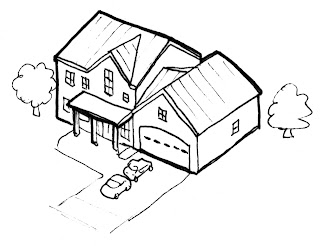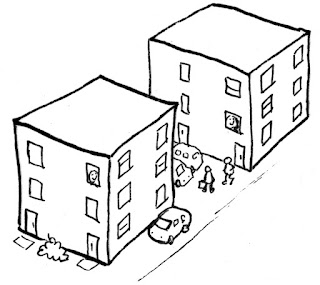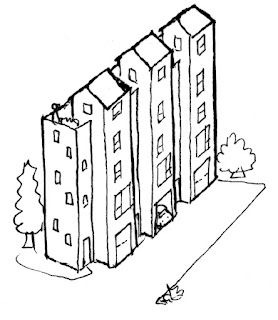Modern Farmhouse / McFarmhouse
Time period: 2010s to present
Location: Suburbs and rural areas
The modern farmhouse has its roots in the late 1980s, starting out as a down-to-earth interior design trend for people tired of or turned off by the shiny glitz of 1980s conspicuous consumption. That said, the farmhouse is also a a status symbol. The gilded penthouse condo stands for financial and industrial wealth, the farmhouse stands for wealth from land ownership. Farmhouse style is based on the farm owner's house, rather than the shacks and labor camps of tenant farmers and migrant farmworkers.
Farmhouse style grew in popularity in the 2010s, through the popularity of home improvement TV shows that showed how old farmhouses could be modernized from merely rustic, to rustic but with modern comfort and style. Compared to the 19th-century and early 20th century farmhouses that serve as inspiration, modern farmhouses are much larger and have modern floorplans.
Modern Farmhouse design features
- Interior and exterior walls painted white. Historically, farmhouses were painted with whitewash, a lime-based paint popular on farms due to its low cost, antibacterial properties, and ease of use.
- Siding on the walls, either wood or cement board.
- Dark gray roof, metal is a popular material.
- Natural wood floors and use of unpainted wood as an accent material, such as columns, trim, etc.
- Large windows and open floor plan. This puts the Modernism in Modern Farmhouse.

Floor plan of a 2-story, 4,000 square foot suburban modern farmhouse on a 1/4 acre lot.
Modern farmhouses aren't only for farms. They're also built in suburbs, with entire tracts of them replacing actual farms. For developers, modern farmhouse is efficient: use one wall material, one paint color for the whole subdivision. Similar to how neutral-colored cars have become popular due to a desire to maximize resale value, the black & white color palette and simple details of a modern farmhouse makes it a perfect commodity, a neutral backdrop that the greatest number of families can see themselves at home in.
The kitchen is the central room in a modern farmhouse. This marks the completion of a 200-year journey of the kitchen from being a utility space to being front and center. Designed for entertaining, this kitchen's finishing touch is the farmhouse sink: an oversize sink so large that it sticks out in front of the countertop. When many restaurants closed in 2020, hosting dinner parties instead of going out surged in popularity, increasing demand for large kitchens.
Two centuries of changing kitchen locations in middle class and upper class houses in the USA.
In the 18th and 19th centuries, large houses often had the kitchen in a
separate building. In hot weather, it kept kitchen heat away. Cooking
was often done by hired or slave workers, and the separation of the
kitchen was part of the separation of classes. Finally, having a
detached kitchen meant that kitchen fires didn't burn down the house.
Improvements in fire safety, ventilation, and air conditioning have made bringing the kitchen into the main living area attractive. Labor costs have gone up, the homeowner is now the cook. There is still an element of conspicuous consumption though - cooking takes time, and in an era when many people have to work more than one job to make ends meet, having time to prepare a large homemade meal is a status symbol.
For those who want to take farm-to-fork to the next level but can't afford or don't have interest in taking care of a multiacre lot, agricultural subdivisions offer the next closest thing. Similar to golf course communities where houses on small lots are clustered between the golf area, agricultural subdivisions, also known as agrihoods, feature clusters of houses between crops. Vineyards are popular due to their upscale image.
Site plan of a 10-acre agricultural subdivision with 35 houses. A project like this could be built in an area that allows 3.5 houses per acre, and would be approved as a Planned Unit Development (PUD). In a PUD, the individual house lots are smaller than what is allowed by zoning, but the entire project stays under the density limit.
Agrihoods can also be urban, with apartment buildings next to the farms. Larger buildings have designs inspired by barns, canneries, and other agricultural buildings. At the highest densities, the farm is on the roof.
Agrihood mixed-use development in Santa Clara, California. In addition to providing produce for the cafe and being a visual amenity, the crop fields also act as a buffer between the housing and the noise and pollution from the main road.
Agrihood farms are limited in operation as their primary purpose is as an amenity for the residential neighbors. Crops are limited to organic vegetables and fruits. In contrast, suburban development next to commercial farms often ends up being an incompatible land use, as homeowners complain about tractor noise, crop spraying, and animal sounds and smells. States have had to pass Right to Farm laws to ensure that new homeowners don't vote to ban existing farmers from doing business.
Farmhouse style has its critics, who take issue with the style being just another type of consumerism. Indeed, some modern farmhouses are basically McMansions with a different facade. However, there are no signs of it slowing down. The 2020s have seen growth of all sorts of rural and imitation rural culture, from country music to cottagecore fashion. In a mirror to urban sprawl invading the countryside, farmhouse style has made its way into the city. Grain elevators have been turned into housing. We may soon see skyscrapers that take design inspiration from agricultural buildings popping up in downtowns across the US.
Farm inspired architecture
Data
- Density: 0.1 to 6 units/acre for rural and suburban farmhouses. Urban agrihoods can reach 50+ units acre, 100+ units/acre with rooftop farms.
- Typical Lot Size: 1/4 acre is a common size for suburban farmhouses. Rural lots are larger.
- Typical Zoning: Single Family Residential, Rural Residential, Agriculture
- Construction Type: Wood Frame
- Resident Type: Homeowner
Where to build
Suburbs and rural areas for modern farmhouses. Agricultural subdivisions and urban agrihoods work best in places where local food is popular.
Further Reading
History of modern farmhouses https://www.curbed.com/article/fixer-upper-modern-farmhouse-design.html
More background info on history and recent evolution of farmhouse style https://www.ohioexteriors.com/the-evolution-of-the-modern-farmhouse-exterior
Info on whitewash paint https://www.countryliving.com/life/a39301/whitewashing-history-farmhouse/
More background info https://www.nar.realtor/magazine/real-estate-news/home-and-design/how-the-farmhouse-went-modern-and-could-be-here-to-stay
Comparison of older and current farmhouse design trends https://www.livingspaces.com/inspiration/ideas-advice/styles/classic-farmhouse-vs-modern-farmhouse
Farmhouse sinks: https://www.customhomegroup.com/blog/pros-and-cons-of-farmhouse-sinks/
18th and 19th century Kitchens in separate buildings: https://archive.curbed.com/2016/6/16/11954538/old-house-kitchen-history-summer
Background on agrihoods https://www.smithsonianmag.com/innovation/how-farms-became-new-hot-suburb-180954956/
Example of agricultural subdivision in Davis, California https://www.bloomberg.com/news/articles/2016-01-22/farming-the-subdivision-in-california-s-central-valley
Urban agrihood in Silicon Valley city of Santa Clara, California, with mid-rise apartment buildings http://www.agrihood-sc.com/
Rooftop farm in Oakland https://oaklandside.org/2022/05/18/oakland-rooftop-medicine-farm-whole-foods/
Rooftop farms in the Bay Area https://topleaffarms.com/portfolio.html
Agricultural lands as wildfire buffer https://www.greenbelt.org/research/the-critical-role-of-greenbelts-in-wildfire-resilience/
Background on right to farm laws https://www.smithsonianmag.com/arts-culture/what-is-the-right-to-farm-and-who-has-it-175894596/
Example of a right to farm law https://library.municode.com/ca/contra_costa_county/codes/ordinance_code?nodeId=TIT8ZO_DIV820RIFA
National database of right to farm laws https://nationalaglawcenter.org/state-compilations/right-to-farm/
Criticism of modern farmhouses https://www.bustle.com/life/farmhouse-aesthetic-suburbs
Conversion and additions to a grain elevator in Baltimore to turn it into housing https://www.multifamilyexecutive.com/design-development/ride-to-the-top_o









Comments
Post a Comment